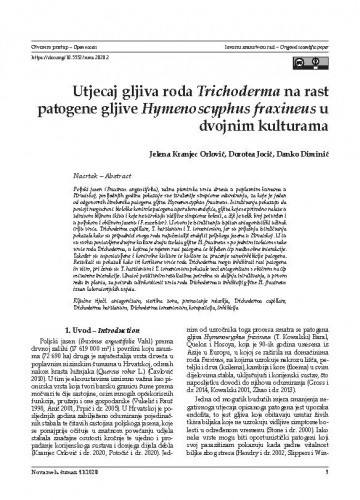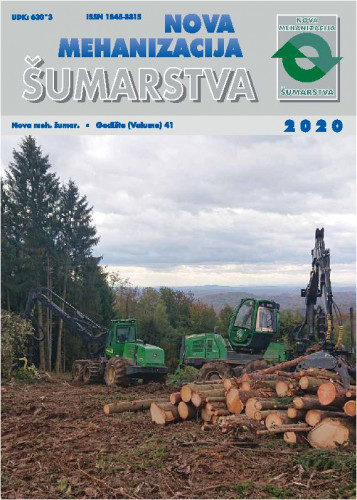Poljski jasen (Fraxinus angustifolia), važna pionirska vrsta drveća u poplavnim šumama u Hrvatskoj, posljednjih godina pokazuje sve izraženije simptome odumiranja, za koje je jedan od odgovornih čimbenika patogena gljiva Hymenoscyphus fraxineus. Istraživanja pokazuju da postoji mogućnost biološke kontrole patogena uporabom endofita, gljiva koje se prirodno nalaze u zdravom biljnom tkivu i koje ne uzrokuju vidljive simptome bolesti, a čiji je velik broj potvrđen i u poljskom i običnom jasenu (F. excelsior). U ovom je istraživanju ispitan antagonistički učinak triju vrsta: Trichoderma capillare, T. harzianum i T. tomentosum, jer su prijašnja istraživanja pokazala kako su pripadnici ovoga roda najučestaliji endofiti poljskoga jasena u Hrvatskoj. U tu su svrhu postavljene dvojne kulture dvaju izolata gljive H. fraxineus s po jednim izolatom svake vrste roda Trichoderma, u kojima je mjeren rast patogena te bilježen tip međusobne interakcije. Također su uspostavljene i kontrolne kulture te kulture za praćenje samoinhibicije patogena. Rezultati su pokazali kako tri korištene vrste roda Trichoderma mogu inhibirati rast patogena in vitro, pri čemu su T. harzianum i T. tomentosum pokazale veći antagonizam s obzirom na tip ostvarene interakcije. Unatoč pozitivnim rezultatima potrebna su daljnja istraživanja, u prvom redu in planta, za potvrdu učinkovitosti vrsta roda Trichoderma u inhibiciji gljive H. fraxineus izvan laboratorijskih uvjeta.; Narrow-leaved ash, an important pioneer tree species in Croatian floodplain forests, is suffering severe dieback in the last years, mostly due to the pathogenic fungus Hymenoscyphus fraxineus. Multiple studies have shown that there is a possibility to control the pathogen with the use of endophytes, fungi that naturally occur in healthy plant tissue without causing any visible disease symptoms. As species of genus Trichoderma were found to be the most common endophytes of narrow-leaved ash root and stem in Croatia, in this research we tested the antagonistic activity of Trichoderma capillare, T. harzianum and T. tomentosum (each represented with one isolate) against H. fraxineus (represented with isolates HF16 and HF 120) in dual cultures. Control cultures with sterile agar plugs and self-inhibition cultures with two plugs of H. fraxineus mycelium were also established. All cultures were prepared in five repetitions, resulting in a total of 50 combinations. Total growth, i.e. the colony radius of H. fraxineus was measured in three directions at four time points, first after 10 days of its independent growth, and then weekly after placing the challenge isolates in cultures. Both H. fraxineus isolates stopped growing in dual cultures with all three Trichoderma species in the period between the second and third measurement, i.e. 7-14 days after confrontation, while the ones in control and self-inhibition cultures continued growing. Fisher LSD test revealed that there was a significant impact of T. harzianum and T. tomentosum on growth reduction of both H. fraxineus isolates compared to pathogen’s growth in control cultures, while T. capillare significantly inhibited the growth of one isolate only (HF16).
Sažetak

 Nova mehanizacija šumarstva : 41(2020) / glavni urednik Mario Šporčić.
Nova mehanizacija šumarstva : 41(2020) / glavni urednik Mario Šporčić.